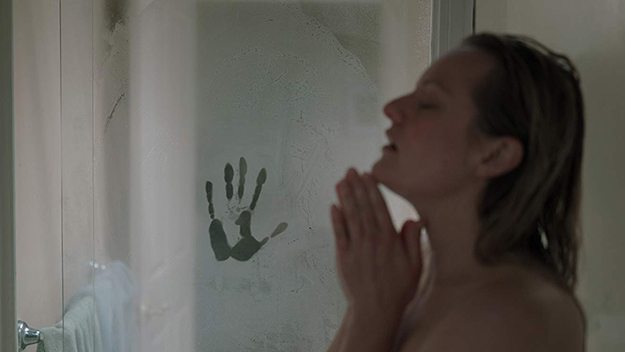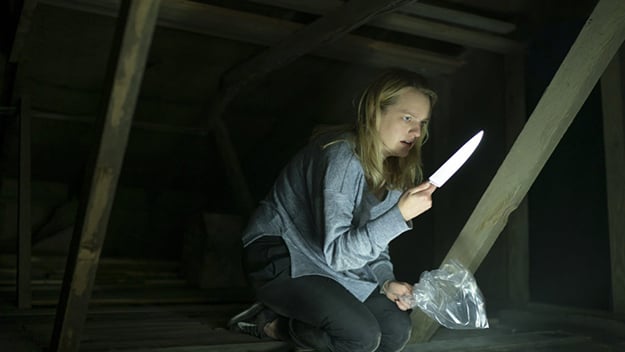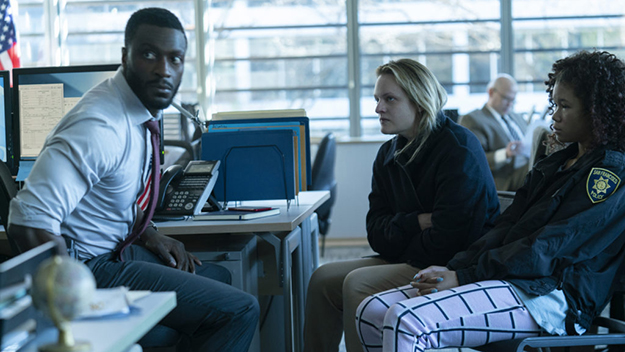Review: The Invisible Man
 Images from The Invisible Man (Leigh Whannell, 2020)
Images from The Invisible Man (Leigh Whannell, 2020)
When, following the box office failure of its 2017 The Mummy reboot, Universal scrapped plans to launch its eagerly touted Dark Universe franchise of interconnected monster movies, the studio announced that it would instead adopt a more modest strategy, drawing on its storied corporate legacy to resuscitate old Universal horror characters in standalone “filmmaker-driven” vehicles, with the goal of fostering a cycle of auteurist studio horror films designed to “appeal to modern audiences.” As Universal’s first outing under this new model, The Invisible Man (from actor-turned-writer-turned-director Leigh Whannell) hints at a new paradigm: in a loose update on James Whale’s comparatively faithful 1933 adaptation of H.G. Wells’s novel, the titular monster is liberated from the moral ambivalence of the old Universal antihero archetype. Instead, the story centers on the object of his predation, rehousing the monster in a more modern horror storytelling formula that pits an unequivocally villainous antagonist—here, an abusive and hyper-controlling husband who becomes vindictive when his wife leaves him—against a virtuous and eminently sympathetic heroine.
As the imperiled woman in question, Elisabeth Moss spends the bulk of the film straining to be believed in her suspicion that her supposedly dead husband is not only alive and lurking undetected, but bent on murderous revenge. Moss convincingly evokes the frayed nerves of a woman accustomed to living under abuse, and to being deprived of a voice. Throughout the film’s first half, she delivers every line as though she might be on the verge of faltering and falling silent—an effect which allows her to plumb the inherent terror of surveillance, of being watched by someone you can’t see, and connects it to themes of paranoia and gaslighting. What if you’re in danger of being hurt by something others can’t see and refuse to believe in? What if, as a result, you’re perceived to pose a danger to others?

Whannell’s retelling situates the character of the invisible man squarely within the generic context of 21st-century studio horror, adapting the premise to play out as a riff on the ghost story framework, in which supernatural forces are swapped out for mortal man’s scientific hubris. In this case, the comparison is further literalized by the fact that Adrian Griffin (who shares a surname with the original Wells creation and with Claude Rains’s character in the 1933 film) is supposed to have died, and no one but his would-be widow Cecilia (Moss) has any reason to believe that he has, in fact, stuck around on the mortal plane to terrorize and torment her. She suspects that he has faked his own death and has somehow found a means of making himself invisible in order to methodically “haunt” her. The film relishes the opportunity to explore the formal implications of that scenario, most notably by drawing attention to the camera’s own invisible presence in the room as it gazes upon Cecilia. Omniscient high-angle shots abound, laying bare every square inch of clinically framed interiors as though through the lens of a surveillance camera, demonstrating a room’s apparent emptiness and daring the viewer to doubt his own eyes.
Whannell is attuned to the inherent silliness of rigorously imagining a technology that would render the human body invisible, and his commitment to the task pays off in the climactic action setpieces of the film’s second half. The challenge of conveying, within the constraints of an audiovisual medium, the potential destructiveness of a human being who can’t be seen, and who goes to great lengths to avoid being heard, is met with wry ingenuity as Cecilia’s plight grows increasingly desperate. Whannell knows that the only reason we have to be afraid of the dark is the ineradicable possibility that unknown threats might be lurking which you can’t detect, and thus against which you can’t possibly hope to defend yourself.

It’s instructive to compare the uses of sound in this film and in the 1933 adaptation, which appeared shortly after the dawn of the talkies in Hollywood. As sound theorist Michel Chion pointed out in his seminal film studies text Audio-Vision: Sound on Screen, the earlier movie made flamboyant use of the new sound film technology, playing with the empirical tension between sound and image to emphasize the invisible man’s “half-embodied voice” as a vehicle for conveying his physical presence in the frame. Here, the invisible man barely speaks at all; his presence is conveyed instead by the imprint of his physical substance (a sheet tugged off a bed, breath condensation in the cold, a subtle indentation on a chair cushion). Whannell’s Griffin is not interested in wreaking havoc in the population at large: his objective is to move through the world undetected and unfeared by all except for his solitary victim, so that she is left utterly isolated in her knowledge of the threat he poses. We can perhaps also extrapolate insight from the differently suggestive modes of invisibility conferred by an ingested drug and by a donned suit: whereas 1933 Hollywood was preoccupied with the fantastic power of a body’s implied sonic imprint to insist on that body’s reality, Hollywood in 2020 is more invested in the sociological question of how a dangerous predator, when sufficiently motivated, can conceal himself within a man-made apparatus that allows him to hide in plain sight.
The result is a potent, sleekly realized allegory for the condition of women (and specifically women in the film industry) in the age of #MeToo. Across professional contexts, but most visibly in the hyper-visible context of mainstream media production, increasingly vocal appeals to “believe women” are a necessary countermeasure to combat the entrenched patriarchal tendency to disbelieve accounts of rape, harassment, and abuse, the widespread emergence of which has been playing out as a major crisis along the entire labor spectrum of the Hollywood workplace. (A radically different generic perspective on this dynamic can be seen in Kitty Green’s recent narrative feature The Assistant, which adopts the rhythms and stylistic approach of a slow-burn psychological thriller to articulate the offenses of a more familiar category of monster.) The villain in The Invisible Man is described as a renowned expert in “the field of optics”—a word choice that underlines the film’s all-too-apt metaphorical framework: the serial abuser as possessor of an invisibility that allows the wielding of terrible power with impunity.
Madeline Whittle is the Programming Assistant at Film at Lincoln Center, and a freelance translator. Her film writing has appeared in Film Comment and The Brooklyn Rail.







